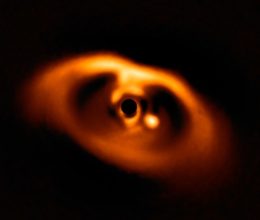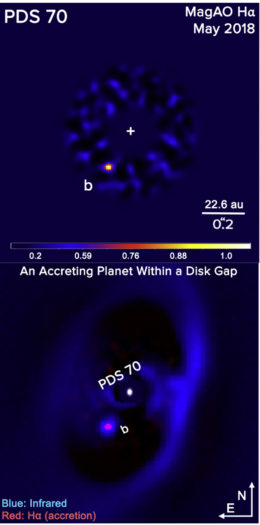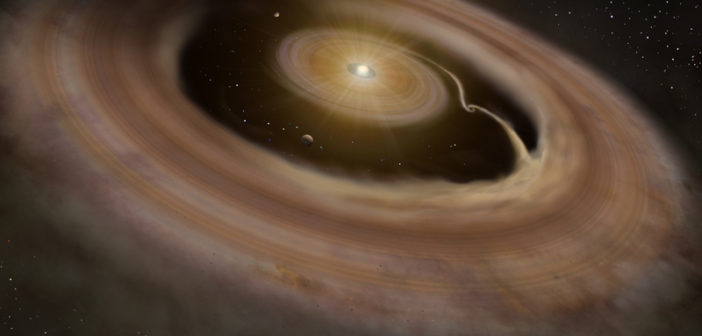
This ALMA image of the protoplanetary disk surrounding the star HL Tauri reveals the detailed substructure of the disk, including gaps that may have been cleared by planets. [ALMA (ESO/NAOJ/NRAO)]
The Search for Evidence
In the recent era of high-resolution observations, indirect evidence of planet formation abounds. In particular, we’ve captured a number of spectacular images of gapped disks surrounding young stars — disks in which we think the first planets of those systems are being born. According to models, planets will grow as they accrete matter from the surrounding protostellar disk, simultaneously clearing a gap in the disk as they orbit.

This image of PDS 70 was taken in the infrared by the SPHERE instrument on ESO’s Very Large Telescope. This is the first clear image of a planet — PDS 70b, visible as the bright spot to the right of the masked-out star — caught in the act of forming. [ESO/A. Müller et al.]
But just demonstrating that a planet lies within the gap isn’t yet enough — the next step is to prove that this planet, PDS 70b, is actively accreting material. This is where high-contrast observations from the Magellan Adaptive Optics system come in.
A Sign of Accretion
In a new study led by Kevin Wagner (University of Arizona, Amherst College, and NASA NExSS Earths in Other Solar Systems Team), a team of scientists used the adaptive optics system on the 6.5-m Magellan Clay Telescope in Chile to image the PDS 70 system in Hα (656 nm) and nearby continuum wavelengths. The presence of Hα emission at the location of the planet PDS 70b would indicate shocked, hot, infalling hydrogen gas — a smoking gun demonstrating that this planet is still accreting matter.

New MagAO Hα observations of PDS 70 reveal the planet as a bright source in the top panel. The bottom panel is a schematic false-color diagram of PDS 70 assembled from the Hα image of the planet (red) and the infrared image (blue) of the thermal emission of the planet and starlight scattered by the disk. [Wagner et al. 2018]
Nearing Full Size
But how fast is it growing, and how far along is it? Wagner and collaborators use their Hα luminosity measurements to calculate a mass accretion rate for PDS 70b, finding that the gas giant is growing at a rate of 10-8±1 Jupiter masses per year. At this rate, and based on the age of the system, the authors estimate that PDS 70b likely accreted mass at a much higher rate in the past, and it has already acquired more than 90% of its final mass.
This nearby planet caught in the act of forming will make for an excellent study target in the future, as we continue to piece together our understanding of how planets are born and grow in protoplanetary disks.
Citation
“Magellan Adaptive Optics Imaging of PDS 70: Measuring the Mass Accretion Rate of a Young Giant Planet within a Gapped Disk,” Kevin Wagner et al 2018 ApJL 863 L8. doi:10.3847/2041-8213/aad695

5 Comments
Pingback: Planet Formation Caught in the Act – Times News | Breaking News International, UFO, Science, History
Pingback: Planet Formation Caught in the Act – AstroBrief
Pingback: A Ringside Seat for Planetary Formation – Northrop Grumman
Pingback: Planetary Cookie Doughs at High Angular Resolution | astrobites
Pingback: Featured Image: A Disk for a Newly Born Planet